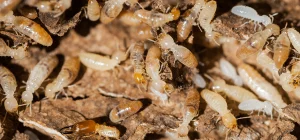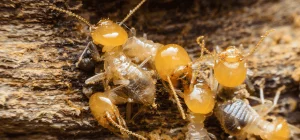If you’ve been a Florida resident for long, chances are you’ve had to deal with termites. Termites infest two million homes a year across the country, causing over $5 billion annually in repairs – but while they’re present across the nation, Florida’s warm, humid climate gives termites a perfect home – specifically, your home.
If you’re a Tequesta resident and you haven’t taken steps to protect your home against termites, you could be putting yourself at risk for thousands of dollars in repairs. For the sake of your wallet and your sanity, termite prevention is a must.
In this article, we’re going to take a look at the types of termites threatening Tequesta residents, warning signs to look out for, and actionable steps you can take to keep your home termite-free for good.
Termites are eusocial insects that form colonies that can contain thousands, often millions of individuals based on the species. The termite life cycle follows a caste system. After hatching from an egg as a nymph, each termite in the colony will develop over time into one of three distinct roles depending on the needs of the colony: workers, soldiers, and reproductives.
- Workers are white, approximately one-eighth inch long in size, and wingless. Workers make up the vast majority of subterranean termite colonies, and are responsible for all the heavy lifting and day-to-day tasks that keep the colony thriving, like tunneling, building and repairing the nest, gathering food, tending to young, and feeding members of the other castes (as they cannot feed themselves). Consequently, worker termites are responsible for most of the damage that comes with a termite infestation.
- Soldiers are beige-colored with large brown heads topped by a set of strong biting mandibles. Soldiers are much less common than workers, and as their name implies, they are responsible for defending the colony from other bugs or animals that try to attack it.
- Reproductives are responsible for one thing: making more termites. They are black and grow to be about one-half inch in body size, though the female’s abdomen will expand to multiple times her size in order to maximize egg production. When they reach maturity, termite reproductives enter a winged (alate) form and form mating flights in which a male and female pair up and fly off to start a new colony. Once they find a suitable location, their wings fall off and the two mate for life, becoming the King and Queen of their new colonies. Once the colony has reached a certain size, the Queen gives birth to new reproductives and the cycle continues.
The two key types of termites threatening Tequesta-area homes are subterranean and drywood termites:
Subterranean Termites
Subterranean termites live and feed in soil and wet wood, generally living underground but occasionally coming to the surface for food. Tenacious eaters, subterranean termites are known to eat through cardboard, paper, wood, foam insulation boards, thin lead and copper sheeting, plaster, asphalt, and some plastics. Their appetites combined with their tunneling behavior
make them extremely destructive to any wooden structures that come into contact with the ground – namely, your home’s foundations.
While subterranean termites are prevalent across the globe, three key species threaten Florida homeowners: the native Eastern subterranean termite as well as its foreign cousins the Formosan subterranean termite and, in recent years, Asian subterranean termites.
Subterranean termites are active throughout the year, generally swarming in the spring. However, Florida’s climate and temperatures can cause mating swarms to form at other times of the year as well, making the problem that much more difficult to treat for Floridians.
Drywood Termites
As their name implies, drywood termites primarily differ from subterranean termites in their feeding habits, preferin dry wood instead of moist or rotten.
Drywood termite colonies are significantly smaller than their subterranean cousins, with populations typically around a few thousand compared to the millions found inside a typical subterranean colony. While this generally means that a drywood termite infestation isn’t as damaging as a subterranean infection, because they spend the entirety of their lives inside wood, a drywood termite infestation can be much more difficult to identify.
In Florida homes, drywood termites are often found in wooden playground sets, in wood piles, in wooden furniture and in wooden building frameworks.
Know the Signs
Prevention is key in any pest control situation, but that’s never truer than when dealing with termites. Part of the reason termite infestations cause so much damage is because they often go on for months or even years before the homeowner becomes aware of the problem. By the time they know they have guests, they’ve already eaten them out of house and home – literally.
Familiarize yourself with some of the most common warning signs of termite invasion, and conduct a thorough inspection of your home for any signs of:
- Signs of tunneling in or around the walls, floors, and foundation of the home, such as dirt buildup, sawdust, or mud tubes formed by subterranean termites
- Buckling, warped, or water-damaged wood at risk of termite infestation – or already under attack
- Hollow sounds when tapping on wooden walls, doors, or furniture indicating tunneling
- Termite droppings (also called frass) in small piles
- Frass – pellet-shaped droppings that drywood termites leave behind, often found in piles close to tunneling sites
- Jamming or sticking in wooden doors and windows as a result of termite damage
- Tapping noises in the wall as termites dig inside it, especially noticeable at night
- Discarded wings leftover from reproductive termites that have formed a colony nearby
So now you know what to look for, but where should you be looking? As you inspect your home, be sure to check in and around these hotspots:

Termite Prevention
After inspecting your home, you should have a better idea about the scope of the problem you’re facing. However, keep in mind that just because you didn’t find any evidence doesn’t mean that an infestation doesn’t exist – and if you have, there’s no telling how bad things might have gotten.
Either way, your best course of action is to keep the situation as contained as possible and prevent further termite presence. The Florida Department of Agriculture and Consumer Services stresses that homeowners employ preventive measures to curb termite presence, so whether or not you’ve found definitive proof of a infestation, use these strategies to keep termites from getting into your home in the future:
Eliminate Moisture: When it comes to termites, prevention is key, and that means making your home as inhospitable as possible. Subterranean termites thrive in moisture-rich environments, so your first step should be to eliminate any sources of excess moisture that could get their attention.
Repair any leaky faucets, pipes, or A/C units throughout the house
- Use a dehumidifier to regulate excess moisture in areas like the attic, garage, and basement
- Ensure gutters and drains are flowing properly
- Find and remove any rotten or water-damaged wood in the house
Keep it Clean: Wood may be termites’ best-known target, but it’s not the only one. Keep in mind that termites in your home aren’t looking for wood itself but rather for the cellulose inside it, which can come in many forms. Termites will feed on any products derived from trees, not just wood, so take measures to deny them what they’re looking for.
- Discard of household clutter like unwanted cardboard boxes, newspaper piles, old photographs, or clothing
- Keep laundry (especially cotton-based clothing) off the ground and away from walls if possible
- Store items in the garage, attic, and basement in metal or plastic containers
Close it Off: Once you’ve made your home as unattractive to termites as possible, take measures to prevent them any easy ways inside. Not only can this step stop deny termites (and other pests) from direct access into the home, it’s also a vital part of keeping out excess moisture from rain or other sources.
- Fix any holes or tears you find in walls, doors, screens, siding, or the foundation that you find
- Get any holes in the roof, attic, fascia, soffits, or shingles professionally repaired
- Check for loose weatherstipping or mortar in the basement foundation and windows
- Keep doors and windows closed whenever not in use, and consider applying a metal mesh or screen where applicable
Clear the Yard: With the home secure, time to shift your focus to the outside. If termites make a home inside objects or clutter around your yard, it’s only a matter of time before they make their way inside, so remove anything that could become a target.
- Discard any debris in the yard that termites could forage into, including dead trees, stumps, scrap wood piles, and waste lumber
- Root out dead trees and plants and clear decaying foliage before it can become submerged into the soil
- Consider switching from wood-based mulch to rubber-based alternatives
Keep a Safe Distance: The closer plants and shrubs are to the home, the easier termites and other pests can use them as a bridge to get inside. Thick shrubbery around the walls can also make it more difficult to identify an infestation, so putting some distance between your house and any landscaping can also make an infestation easier to identify should one be present.
- Keep at least 12-18 inches between the home and any plants, shrubs, or soil
- Store firewood at least 20 feet from the home, elevated off the ground if possible
- If your home has already been treated for termites, don’t dig within a foot of the home as this could disturb the soil enough to allow termites to pass through
Routine Inspections: The main reason that termite infestations are as costly and damaging as they are is because they often go on for months or even years before the homeowner even knows there’s a problem. Just because you didn’t see anything last time doesn’t mean there couldn’t be something there today, so homeowners need to be constantly vigilant.
- Inspect your home at regular intervals for any signs of termite damage, especially in spring as the temperatures rise
- Keep an eye on the moisture levels in the attic and basement and use a dehumidifier if necessary
- Schedule a professional yearly inspection to ensure you’re protected
Termite Treatment
Termites can be incredibly difficult pest to treat, especially if you try to do it alone. Even if you know the warning signs, tracing the problem to its source and putting a stop to it is another story entirely. And even if you eliminate the infestation today, there’s no guarantee that it won’t be back in force later on. If you want real, lasting protection from termites and the destruction they cause, the safest option is always to get a professional treatment from a certified pest control company.
The team at Nozzle Nolen knows termites better than anyone else in the state of Florida. If your home is under attack from termites, or you fear it could come under attack in the future, contact us for a consultation or visit our residential pest control page to learn more about the different options Nozzle can provide.

